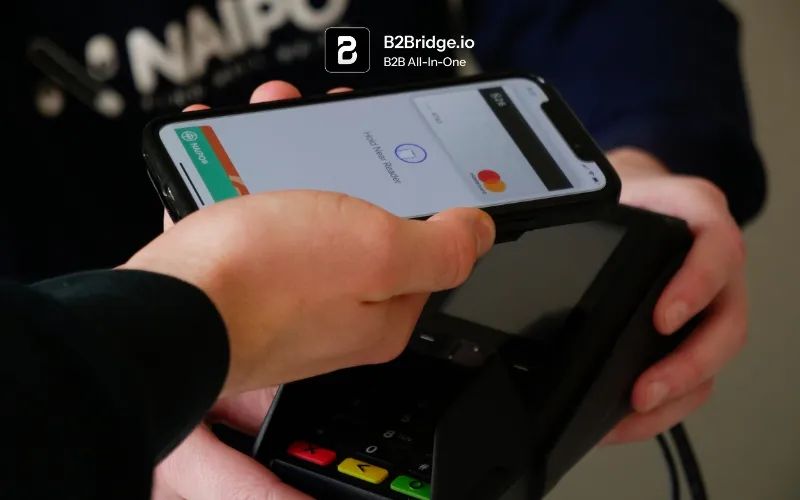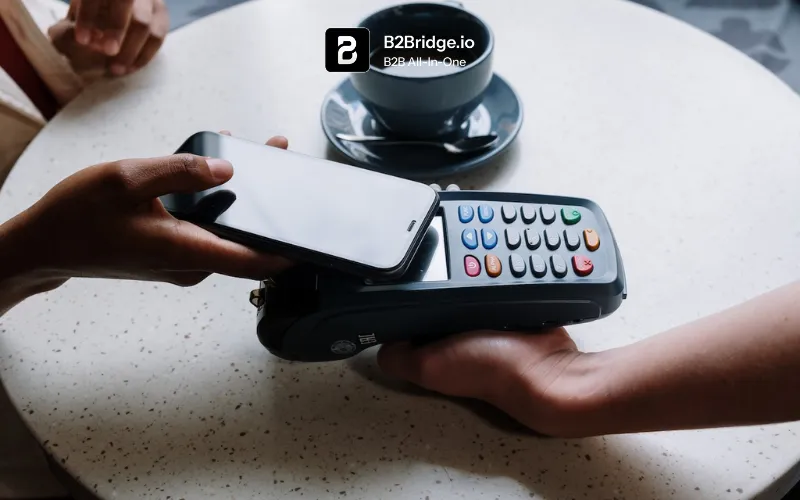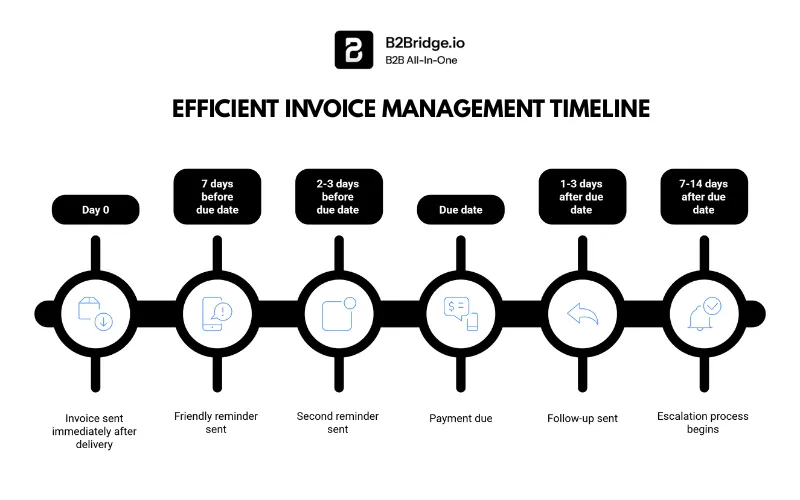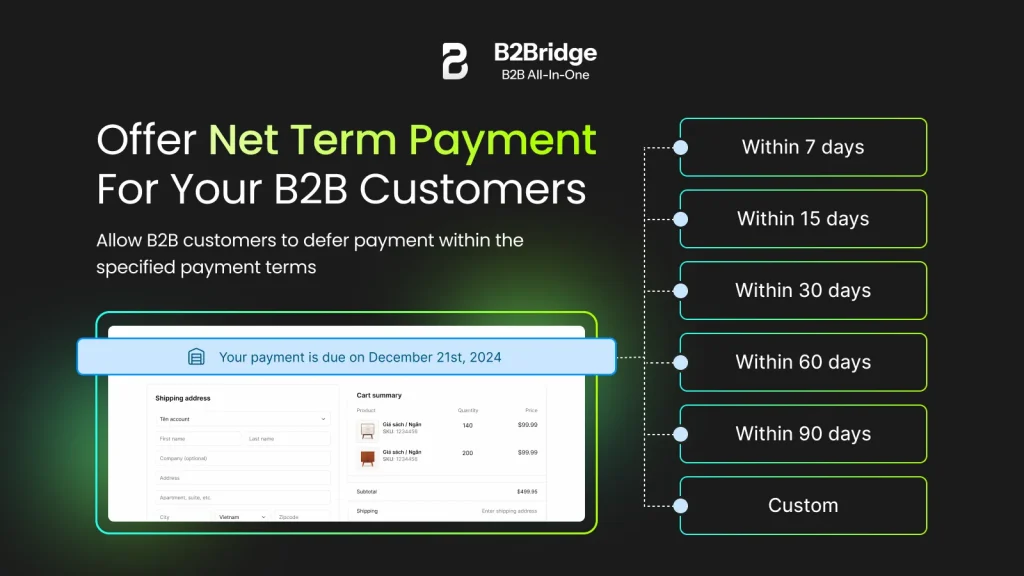To calculate net payment terms, add the number of days specified in the term to the invoice date to determine the due date. If an early payment discount applies (e.g., “2/10 net 30”), multiply the invoice total by the discount percentage to find the discount amount, then subtract it from the total to get the discounted payment due within the early payment period.
Net payment terms like Net 30, 60, or 90 are essential in B2B trade, offering buyers flexibility and helping sellers build strong relationships. However, extended terms can lead to cash flow risks. This guide explains what net terms are, how to calculate net payment terms and manage them, and how to offer competitive terms without hurting your financial stability.

What Are Net Payment Terms?
Net payment terms refer to the agreed-upon timeframe within which a buyer must pay an invoice in full after receiving goods or services. These terms are standard in B2B transactions and serve as a form of short-term credit that sellers extend to qualified buyers.
The “net” in net payment terms indicates that the full invoice amount is due without any deductions. For example, “Net 30” means the buyer has 30 days from the invoice date (or delivery date, depending on your agreement) to remit full payment.

Net payment terms play a crucial role in B2B Ecommerce by:
- Facilitating larger purchase orders that buyers might not be able to pay for immediately
- Building trust and long-term relationships between suppliers and customers
- Creating competitive advantages for sellers willing to offer flexible payment options
- Managing cash flow cycles for both parties in the transaction
Commonly Used Net Terms: Net 0 (Cash on Delivery), Net 15, Net 30, Net 60, Net 90
The longer the payment window, the more financial flexibility buyers receive – but the greater the cash flow burden on sellers.
What is Net 30?
Net 30 is a payment term commonly used in business-to-business (B2B) transactions. It means that the customer must pay the full invoice amount within 30 calendar days of the invoice date.
Example: A retailer orders $15,000 in inventory on January 10th. With Net 30 terms starting from the invoice date (January 10th), payment is due by February 9th.
Net 30 works well for:
- Established customer relationships
- Standard wholesale transactions
- Retail buyers managing monthly inventory cycles
- Balancing competitive terms with reasonable cash flow
What is Net 60?
Net 60 is a payment term in B2B transactions where the buyer must pay the full invoice amount within 60 days from the invoice date. It is commonly used for larger orders, seasonal businesses, trusted partners, manufacturers, wholesalers, and enterprise or government contracts.
When to use Net 60:
- Large, creditworthy customers with proven payment history
- Seasonal businesses that need longer payment cycles
- High-value contracts where extended terms close the deal
- Industries with longer sales cycles
Example: You supply $50,000 in goods to a large retailer on April 1st. With Net 60 terms, they have until May 31st to pay.
What is Net 90?
Net 90 is a payment term meaning that the buyer must pay the full invoice amount within 90 days from the invoice date. This extended payment window is commonly used in B2B transactions involving enterprise clients, large-scale projects, seasonal industries, or strategic accounts.
This is typically reserved for:
- Major enterprise customers with excellent credit
- Government contracts that often require extended terms
- Very large order values
- Strategic partnerships where extended credit builds loyalty
Example: A government agency orders $100,000 in supplies on July 1st with Net 90 terms. Payment isn’t due until September 29th.
Critical consideration: With Net 90, you’re essentially providing 90 days of free financing. Ensure your cash flow can support this before offering these terms.
What is 2/10 Net 30?
2/10 Net 30 is a common trade credit payment term used in business-to-business transactions. It means that the buyer can receive a 2% discount on the invoice total if the payment is made within 10 days of the invoice date. If the buyer does not take advantage of this early payment discount, then the full invoice amount is due within 30 days from the invoice date.

The term “2/10 Net 30” is a common discount structure that incentivizes early payment
- 2% discount if paid within 10 days
- Net 30 means the full amount is due within 30 days without the discount
Calculation Example:
- Invoice Amount: $10,000
- Invoice Date: October 1, 2025
- Early Payment Discount: 2% ($200)
- Early Payment Due Date: October 11, 2025 (pay $9,800)
- Standard Payment Due Date: October 31, 2025 (pay $10,000)
If the buyer pays by October 11, they save $200. If they pay between October 12 and October 31, they pay the full $10,000. This structure encourages faster payment while still offering the flexibility of 30-day terms.
What is the Late Payment Interest Rate for Net term?
The late payment interest rate for net terms typically ranges between 1% and 2% per month on the overdue invoice amount, though the exact rate can vary depending on contractual agreements and local laws.
For example, some businesses charge a monthly interest rate to incentivize timely payments, which accumulates the longer the invoice remains unpaid after the agreed net term (e.g., Net 30, Net 60, Net 90).
How Net Terms Impact Cash Flow and Business Relationships
Net payment terms directly affect your business’s cash flow. When you offer Net 30 terms, for instance, you’re essentially providing an interest-free loan for 30 days. This can strain your working capital, especially if you have expenses like inventory costs, payroll, or operational overhead that can’t wait.
However, net terms also strengthen business relationships. Buyers prefer working with suppliers who offer flexible payment options, as this helps them manage their own cash flow and purchase larger quantities. This competitive edge can lead to increased order volumes, customer loyalty, and long-term partnerships that drive sustainable growth.
How Do Net Payment Terms Work?
Net payment terms begin when an invoice is issued (or when goods are delivered, depending on your agreement). The buyer receives the invoice along with the payment terms clearly stated, typically in the format “Net [number of days].”
Here’s how the process typically unfolds:
- Transaction Completion: You deliver goods or complete services for your customer
- Invoice Generation: You issue an invoice with clear net payment terms
- Payment Period: The buyer has the specified number of days to pay
- Payment Processing: The buyer submits payment before the due date
- Follow-up (if needed): You send reminders or enforce late payment policies if the deadline passes
The key to successful net payment terms is clear communication from the start. Both parties should understand when payment is due, what happens if terms aren’t met, and any early payment incentives that might apply.

Who Offers Net 30/60/90 Terms?
Invoice-Based Businesses
Any business that operates on an invoice-based model can offer net payment terms. This includes service providers, consultants, and professional firms that bill clients after completing work. These businesses benefit from net terms because they help secure larger contracts and build trust with enterprise clients who expect flexible payment options.
B2B Businesses
B2B companies are the primary users of net payment terms. Whether you’re selling products or services to other businesses, offering net terms is often expected – and sometimes required – to remain competitive. Industries like wholesale, distribution, manufacturing, and professional services rely heavily on these arrangements to facilitate commerce at scale.
Suppliers
Suppliers and distributors frequently offer net payment terms to retailers, restaurants, and other businesses that need to manage inventory purchases carefully. This is particularly common in industries with seasonal demand or long product cycles, where buyers need time to sell goods before paying their suppliers.
Advantages and Disadvantages of Offering Net Payment Terms
Benefits to Sellers and Buyers
For Sellers:
- Competitive differentiation in crowded markets
- Increased order volumes as buyers can purchase more
- Stronger customer relationships built on trust and flexibility
- Access to larger clients who expect net terms as standard
- Predictable revenue cycles when terms are managed properly
For Buyers:
- Improved cash flow management by deferring payment
- Ability to purchase larger quantities without immediate cash outlay
- Time to generate revenue from products before paying suppliers
- Better inventory planning without cash constraints
- Simplified bookkeeping with clear payment schedules
Risks and Challenges (Cash Flow Issues, Defaults)
While net payment terms offer significant benefits, they also carry risks:
Cash Flow Gaps: The longer your payment terms, the longer you wait for revenue. This can create working capital shortages, especially for smaller businesses or those with thin profit margins.
Late Payments and Defaults: Not all customers pay on time. Late payments disrupt your cash flow projections, while defaults can result in significant losses. According to industry research, late B2B payments remain a persistent challenge across industries.
Administrative Burden: Managing net terms requires tracking invoices, sending reminders, following up on late payments, and potentially pursuing collections – all of which consume time and resources.
Credit Risk Assessment: You need systems to evaluate which customers qualify for net terms and which payment windows they can access, adding complexity to your operations.

Industry-Specific Considerations
Different industries have varying standards for net payment terms:
- Wholesale and retail: Net 30 is standard, with Net 60 for larger or seasonal orders
- Manufacturing: Net 60 or Net 90 for large equipment or bulk materials
- Professional services: Net 15 or Net 30 for consulting and agency work
- Food and beverage: Net 30 for distributors, often shorter for perishables
- Technology and SaaS: Often subscription-based rather than net terms
How to Calculate Net Payment Terms
Calculating net payment terms is straightforward:
Payment Due Date = Invoice Date + Number of Net Days
Before setting your net terms, analyze your industry standards, client payment history, cash flow, and invoice size to ensure they align with your business goals.
Step 1: Consider your industry
Net 30 is common, but payment timelines vary by sector. For example, construction often uses 90 days, while food, hospitality, and retail may expect payment within 3 days. Research your industry’s norms to set realistic expectations.
Step 2: Evaluate client history
Offer flexible terms based on reliability. Trusted clients may earn Net 60, while those with late payments may need shorter terms like Net 15 to encourage timely payments.
Step 3: Review your cash flow
Use the formula below to gauge how long it typically takes to collect payments:
Average Collection Period = (Average Accounts Receivable / Net Credit Sales) × 365
For example, if your average receivables are $10,000 and annual net credit sales are $150,000, your collection period is around 24 days – suggesting Net 15 or Net 30 terms work best.
Step 4: Adjust for invoice size
Larger invoices may justify longer payment terms to ease the client’s burden and strengthen your business relationship, while smaller invoices can use shorter terms.
Net Payment Terms vs. Other Payment Methods
Net Payment Terms vs. Credit Cards
| Aspect | Net Payment Terms | Credit Cards |
| Payment Timing | Full payment due by a specific date | Immediate payment to seller (minus fees) |
| Seller Transaction Fees | No transaction fees | Transaction fees typically 2-3% |
| Credit Evaluation | Requires credit evaluation and trust | Buyer subject to credit card issuer evaluation |
| Buyer Cost | No direct buyer fees, may incur late fees | Buyer pays interest if balance is carried |
| Administrative Burden | Higher; requires credit management | Lower; simpler payment processing |
| Relationship Building | Builds long-term business relationships | Less focused on relationship building |
| Payment Limits | Dependent on seller credit terms | Limited by credit card limits |
| Advantages | No fees for seller, supports trust and relationships | Immediate funds, reduces seller admin work |
| Disadvantages | Risk of late payments, credit management needed | Fees reduce seller revenue, buyer limited by credit card |
| Best Use Cases | Established clients, larger or repeat orders | Quick payments, smaller or ad hoc transactions |
Net terms are generally preferable for large B2B transactions where credit card fees would be prohibitive and where building ongoing relationships matters.
Net Payment Terms vs. Cash on Delivery (Net 0)
| Aspect | Net Payment Terms | Cash on Delivery (Net 0) |
| Payment Timing | Payment deferred after delivery | Immediate payment upon receipt |
| Buyer Flexibility | High; allows buyer flexibility | Low; less convenient for buyers |
| Seller Cash Flow Impact | Creates cash flow gap for seller | No cash flow gap |
| Credit Risk | Requires trust and creditworthiness | Minimal credit risk |
| Relationship Building | Better for building long-term relationships | Less focused on relationship building |
| Order Size Limitations | Suitable for larger orders | May limit order sizes |
| Convenience for Buyer | More convenient | Less convenient |
| Advantages | Builds long-term relationships | Immediate cash flow, reduces credit risk |
| Disadvantages | Cash flow gap, requires credit evaluation | Limits order size, less buyer flexibility |
| Best Use Cases | Established customers, larger volumes | New customers, high-risk transactions, smaller orders |
COD works well for new customers, high-risk transactions, or smaller orders, while net terms are better suited for established relationships and larger volumes.
Net Payment Terms vs. Partial/Milestone Billing
| Aspect | Net Payment Terms | Partial/Milestone Billing |
| Payment Timing | Payment deferred after delivery | Payments made at defined project milestones |
| Buyer Flexibility | High; allows buyer flexibility | Moderate; tied to project progress |
| Seller Cash Flow Impact | Creates cash flow gap for seller | Improves cash flow by receiving partial payments |
| Credit Risk | Requires trust and creditworthiness | Reduced risk due to staged payments |
| Relationship Building | Better for building long-term relationships | Encourages collaboration through project phases |
| Order Size Limitations | Suitable for larger orders | Suitable for large projects with clear phases |
| Convenience for Buyer | More convenient | Provides more control over payment schedule |
| Advantages | Supports larger volume sales, builds trust | Enhances cash flow, reduces risk, aligns payments with progress |
| Disadvantages | Cash flow gap, requires credit evaluation | Requires clear milestones, may complicate billing process |
| Best Use Cases | Established customers, ongoing supply relationships | Complex projects, customized orders, long delivery times |
Milestone billing is ideal for large projects or custom orders, while net terms work better for standardized products and repeat transactions.
How to Use Net Payment Terms without Affecting your Cash Flow
Clear Communication and Contractual Terms
Always establish payment terms before beginning work or shipping products. Your invoices, quotes, and contracts should clearly state:
- Exact payment terms (Net 15, 30, 60, or 90)
- Whether the due date is based on invoice date or delivery date
- Accepted payment methods
- Late payment fees and policies
- Early payment discounts (if applicable)
Clear documentation prevents disputes and sets professional expectations from the start.
Prompt Invoicing and Payment Reminders
Send invoices immediately after delivery or service completion. The sooner you invoice, the sooner the payment clock starts. Consider this reminder schedule:
- Invoice sent: Day 0
- Friendly reminder: 7 days before due date
- Second reminder: 2-3 days before due date
- Payment due: Due date
- Follow-up: 1-3 days after due date
- Escalation: 7-14 days after due date

Automated reminder systems can handle this workflow without manual intervention, ensuring consistent follow-up.
Late Payment Policies and Fees
Establish and communicate your late payment policy upfront:
- Late fees: Typically 1-2% per month on overdue balances
- Grace period: Consider a 3-5 day grace period before applying fees
- Suspension of services: When services or future orders will be paused
- Collections process: When you’ll pursue formal collections
Having a documented policy protects your business while maintaining professional relationships.
Tracking and Reporting on Outstanding Invoices
Implement a system to monitor accounts receivable:
- Aging reports: Track invoices by age (0-30, 31-60, 61-90, 90+ days)
- Customer payment history: Identify reliable payers vs. chronic late payers
- Cash flow projections: Forecast incoming payments based on outstanding invoices
- DSO (Days Sales Outstanding): Calculate average collection period
Regular reporting helps you identify problems early and make informed credit decisions.
Leveraging Digital Platforms and Automation
Modern B2B platforms eliminate much of the manual work involved in managing net payment terms:
- Automated invoicing that generates and sends invoices instantly
- Payment reminders sent automatically at predetermined intervals
- Customer portals where buyers can view invoices and payment history
- Integration with accounting systems like QuickBooks or Xero
- Real-time reporting on cash flow and outstanding payments
Tools like B2Bridge simplify the entire process, allowing you to offer competitive payment terms without overwhelming your team with administrative work.
Risks and Challenges of Net Payment Terms
Credit Risk and Late Payments
The primary risk of net payment terms is non-payment or chronic late payment. Consider these statistics:
- Late B2B payments can tie up 20-30% of a business’s working capital
- Approximately 64% of B2B invoices are paid late
- The average late payment in B2B transactions exceeds 20 days beyond terms
Managing credit risk:
- Conduct credit checks on new customers
- Start with shorter terms (Net 15 or Net 30) for new relationships
- Implement credit limits based on customer creditworthiness
- Use credit reporting agencies for larger customers
Cash Flow Impact
Extended payment terms directly affect your cash flow. When you offer Net 60 or Net 90, you’re financing your customer’s operations.
Example impact: If you have $200,000 in monthly sales on Net 60 terms, you’re effectively carrying $400,000 in accounts receivable at any time – cash that’s owed but not yet collected.
Administrative Burden
Managing net payment terms requires:
- Invoice tracking and payment monitoring
- Collection procedures for overdue accounts
- Customer communication about payment status
- Accounting reconciliation
- Credit management processes
Without proper systems, this administrative work can overwhelm small teams.
Best Practices for Managing Net Payment Terms to Avoid Risks
Customizing Terms for Different Customers and Orders
Not all customers deserve the same payment terms. Consider tiering your terms based on:
Customer Creditworthiness:
- New customers: Net 15 or COD until trust is established
- Established customers: Net 30 or Net 60
- Strategic accounts: Net 60 or Net 90
Order Size:
- Small orders: Shorter terms or COD
- Large orders: Extended terms to facilitate bigger purchases
- Recurring orders: Stable terms that match payment cycles
Payment History:
- Reliable payers: More favorable terms
- Late payers: Shorter terms or COD until history improves
- Defaulters: No credit terms until resolved
This customized approach balances growth opportunities with risk management.
B2Bridge offers robust tools that enable merchants to customize payment terms based on customer creditworthiness, order size, and payment history, empowering businesses to balance growth opportunities with risk management effectively.
Balancing Growth with Risk Management
Scaling with net payment terms requires careful balance. Consider these strategies:
- Credit Limits: Set maximum outstanding balances per customer to cap exposure
- Credit Insurance: Protect against defaults on large accounts
- Factoring or Invoice Financing: Convert outstanding invoices to immediate cash when needed
- Reserve Funds: Maintain cash reserves to cover operating expenses during payment cycles
- Regular Review: Reassess customer terms quarterly based on payment behavior
The goal is to offer competitive terms that drive growth without creating unsustainable cash flow pressures.
Case Studies and Real-World Examples of Net Payment Terms
Small Business Using Net 30 to Improve Cash Flow
Background: A small coffee roastery was struggling to compete with larger suppliers who offered Net 30 terms to cafes and restaurants.
Challenge: Limited working capital made it difficult to extend credit while covering bean purchases and operational costs.
Solution: The roastery implemented automated invoicing with B2Bridge, started with Net 15 terms for new customers, and graduated reliable customers to Net 30. They also secured a small line of credit to bridge cash flow gaps.
Result: Within six months, order volumes increased 40%, customer retention improved, and the business secured several large cafe chains as regular customers. The automated system reduced administrative time by 15 hours per week.
Wholesale Brand Scaling with Net 60 Payment Terms
Background: A sustainable apparel brand wanted to expand into larger retail chains that required Net 60 terms.
Challenge: The brand’s cash conversion cycle couldn’t support 60-day payment windows without external financing.
Solution: They negotiated Net 30 terms with their fabric suppliers, implemented strict creditworthiness checks for Net 60 customers, and used invoice financing for large orders.
Result: The brand successfully onboarded three major retail chains, tripling wholesale revenue in one year. Clear payment tracking and automated reminders kept payment collections smooth, with a 92% on-time payment rate.
Handling Late Payments and Mitigating Risk Effectively
Background: A food distributor faced chronic late payments from 30% of customers, creating serious cash flow problems.
Challenge: Manual tracking made it difficult to identify patterns and enforce payment policies consistently.
Solution: They implemented automated payment reminders, established clear late fee policies, and created a tiered system where late payers were moved to shorter terms or COD.
Result: Late payments dropped to 12% within three months. The distributor recovered $45,000 in overdue invoices and improved overall cash flow by 25%. Problem accounts either improved their payment behavior or were transitioned to COD.
Introducing B2Bridge: Simplify Your B2B Wholesale Payment Terms
Managing net payment terms manually becomes increasingly complex as your wholesale business grows. Multiple customer tiers, different terms for different accounts, payment tracking, and collections follow-up can quickly overwhelm even organized teams.

B2Bridge simplifies net payment terms management for Shopify wholesale sellers with:
- Flexible payment terms assignment: Set unique net terms (Net 15, 30, 60, 90, or custom) for individual customers or customer groups
- Automatic calculation: Due dates calculate automatically based on your configured terms
- Clear customer communication: Payment terms display prominently during checkout and on invoices
- Seamless Shopify integration: Works natively with your Shopify store – no complex ERP required
Whether you’re just starting to offer net terms or managing hundreds of wholesale customers with varied payment arrangements, B2Bridge provides what you need to scale professionally.
Ready to simplify your wholesale payment terms? Explore how B2Bridge can help you offer flexible payment options while maintaining control of your cash flow.
FAQs About Net Payment Terms
Net term payment is an agreement where the buyer pays the full invoice amount within a specified number of days after receiving goods or services, such as Net 30 or Net 60.
Net 15 means the buyer must pay the full invoice amount within 15 days of the invoice date or delivery date, depending on the agreement.
This means a $6,000 invoice with payment due within 30 days. The buyer must pay the full $6,000 within 30 days from the invoice or delivery date.
Net payment refers to the full amount due without deductions, paid within the specified timeframe stated in the payment terms.
Late payment may result in fees, interest charges, suspension of services, loss of credit privileges, or collection actions depending on the seller’s policies.
Net terms refer to when payment is due (like Net 30). Gross typically refers to the total amount before deductions, but this isn’t standard payment term terminology.
Conclusion
Net payment terms are essential tools for B2B businesses looking to compete effectively, build strong customer relationships, and scale sustainably. Whether you’re offering Net 15, 30, 60, or 90 terms, understanding how to calculate, manage, and optimize these arrangements is crucial for financial success.
As your wholesale business grows, manual management becomes unsustainable. Modern B2B platforms like B2Bridge automate the complex work of managing payment terms, invoicing, and collections – allowing you to offer competitive terms without sacrificing operational efficiency or cash flow control.
Ready to streamline your B2B payment term management? Discover how B2Bridge can help you scale your wholesale business with confidence. [Learn more today].
Hi, I’m Ha My Phan – an ever-curious digital marketer crafting growth strategies for Shopify apps since 2018. I blend language, logic, and user insight to make things convert. Strategy is my second nature. Learning is my habit. And building things that actually work for people? That’s my favorite kind of win.


